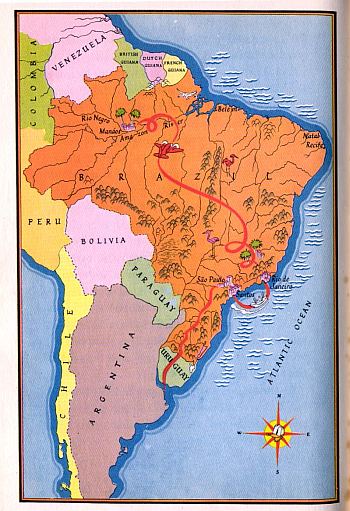Travel Tales
Brazil,
Plenty of Problems, Poverty and Panorama
Brazil became an independent nation in 1822, following three centuries under the rule of Portugal. In 1957, Lucio Costa presented his plan for the new capital of Brazil called "Brazilia" which later became its capital in 1960. The name was derived from the brazilwood trees that grew in the forests in the northern part of South America. With a population of 169,799,170 it is the most populous country in Latin America, and the leading economic power in that region.
Deforestation in the Amazon Basin destroys the habitat and endangers a multitude of plant and animal species indigenous to the area, producing a lucrative illegal wildlife trade. AIDS is a big problem in that country, resulting in lower life expectancy and lower population and infant mortality. Their ethnic group comprises of white Europeans by 55%, Portuguese, German, Italian, Spanish and Polish. 6% of their population is Black and 1% includes Japanese, Arab, and Amerindian. There are 26 states, "estados" in the country such as Acre, Amapa, Bahia, Distrito Federal, Maranhao, Mato Grosso, Pernambuco, Rio de Janeiro, Rondonia, Sao Paulo, Tocatins, etc.


When we took a cruise our ship docked in Rio de Janeiro, which has one of the most beautiful harbors in the world, with its huge statute of Christ with outstretched arms atop Sugarloaf Mountain, overlooking the sea. After shopping, we stopped for a quick swim at the famous Copacabana Beach. At night all lit up it is certainly a magnificent sight with the city's sparkling lights reflecting off the water and one of my most memorable impressions. Our ship also docked at Recife, Santos, and Porto Alegre, where we bought enormous straw hats made by the locals. The night life at the discos is colorful, loud, and very entertaining. Brazilians love to dance their samba and bossa nova, and of course, their Carnivals are legendary.
Unfortunately, Brazil has its problems like everywhere else these days and the unruly region at the convergence of Argentina-Brazil-Paraguay borders is a hotbed of money laundering, smuggling, arms and illegal narcotics trafficking, and even fundraising for extremist organizations. There is a minor coca cultivation in the Amazon region which is used for domestic consumption and the government has embarked upon a large-scale eradication program to control cannabis. An important transshipment area for Bolivia, Colombia and Peruvian cocaine headed for Europe and the USA, causes drug-related violence and significant illicit financial activity in this Tri-Border location.
In speaking with Brazilians, here in Florida, I am told that they have left their country "because of its economic difficulties with the overwhelming poverty and political corruption." Brazil's economy outweighs that of all other South American countries, but the IMF has reinforced a series of an inflation-targeting regime, a tight fiscal policy, and a floating exchange rate.
Green and yellow flags can be seen lining US-I Highway around Broward County area as Brazilians open supermarkets, auto agencies, real estate offices, and pawn shops, as they settle into a more moderate type of life. But waiting in line is not part of their culture as their hot-tempers and Latin exuberance refuses to tame their impatience to do things the "Anglo way."
One of the adventures on my To Do Before I Die List, is to travel by boat on the Amazon river from Belem to Manaus, avoiding the Peruvian border for safety reasons, but certainly taking photos of the flora and fauna, and taking a look at their gorgeous orchids and parrots. For all its social problems, Brazil is the loveliest country for breathtaking scenery in all of South America.
Alinka
Read Travel Tales in the Archives.
